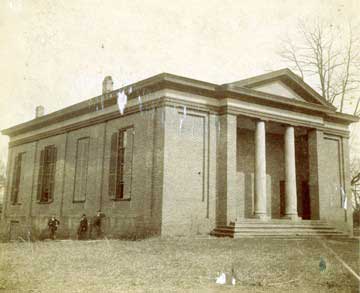Almost immediately after the Hampden-Sydney College classes began on November 10, 1775, the Cumberland Presbyterian Church that was nearly a dozen miles away established an outpost preaching site in the college’s original classroom building. The Cumberland church officers also encouraged other nearby Prince Edward residents to attend these Sunday afternoon worship services, also urging those families to bring their slaves to these same religious services. Indeed, although these services were primarily intended as an evangelistic and pastoral outreach to the nearly one hundred original college enrollees, this open invitation fixed the fact that during the nearly two and a half centuries since then there has always been a noteworthy rural component in the College Church congregation. Another major membership group during the first century of this congregation’s history came from the residents of the Prince Edward Court House village (present-day Worsham), prior to the transfer of this county seat into Farmville in 1872.
After a three-year post-graduate Presbyterian seminary was founded 1/8 of a mile south of the college in the 1820s, the congregation purchased approximately four acres half-way between these two academic institutions in order to provide regular worship and pastoral care for the students and faculty from both schools. At this period there was no expansive open campus for either of these schools that essentially “sat out there in the isolated woods.” Therefore, a natural place for students to gather each Sunday — often to have social exchanges with the numerous faculty and farmers’ daughters — was at this little country church. In fact, for years prior to there being student-owned automobiles, many “church-related courtships” for both college and seminary students and local young women blossomed into successful 19th century marriages.

The present Greek Revival building was constructed in 1860-61. Its architect was Robert Lewis Dabney, a seminary theology professor; its local contractor was Richard Thackston (a nearby resident who had descendants in this church well into the 20th century); the hand-made bricks were formed from local clay and baked on site by black slaves and freedmen. In 1919 a church manse for the resident pastor was built on College Road immediately north of the church, and nearly a century later that brick house still serves as the pastor’s residence. A modestly functional church basement was excavated in 1955, and an educational building (with adequate kitchen and fellowship hall), was added in 2001-2002.
It has been nearly a century since the college has had its own separate religious chapel, but the congregation’s building often functions unofficially in that capacity. Baccalaureate and Commencement services were regularly held there until the mid-20th century. Interestingly, as the college’s open campus continued to expand, all of the congregation’s four acres with church, manse, and cemetery space may appear to be college property, although they are not; instead, they form a separate real estate “doughnut hole” in an otherwise continuous campus.
Since the early 1950s the pastor of the congregation (that now includes residents from Hampden-Sydney and the surrounding rural area, as well as people from both Farmville and Longwood University) has been defined as a half-time position, with the other half of that person’s duties being assigned as that of “the college chaplain” (a pastor as needed for the entire faculty, administration, trustees, more than a thousand students, and dozens of other college employees. The church and the college share that person’s salary.
When the educational building was completed in 2002, the congregation approved a forty-year legal agreement with the college that classroom space in this building could be used by the college for weekday instructional purposes, with the college’s assumption of an appropriate share of its physical maintenance.

Burial spaces in the church cemetery, however, are not available for the general public, being limited only for those in the congregation. This part of the church property, along with its perpetual care endowment, is administered by a separate Church Cemetery Committee.
The Rev. Dr. William E. Thompson
Pastor Emeritus, College Presbyterian Church and Retired Chaplain, Hampden-Sydney College
For further historical information, see Dr. Thompson’s Her Walls Before Thee Stand: The 235 Year History of the Presbyterian Congregation at Hampden-Sydney, Virginia (2010) available at the Hampden-Sydney College book store and Bortz Library and the Greenwood Library on the campus of Longwood University.




